This post contains affiliate links.
This article identifies and describes Rhode Island hummingbirds, where in Rhode Island they are seen, and whether they are year-round, seasonal, or rare vagrant residents.
Which Species Of Rhode Island Hummingbirds Are Found In The State?
There are three species of hummingbirds documented as seen in Rhode Island.
Documented Rhode Island hummingbirds, listed in order of frequency seen are Ruby-throated, Rufous, and Calliope hummingbirds.
Top Google-ranked websites recognize three additional hummingbirds, the Allen’s, Anna’s and Broad-tailed hummingbirds, as Rhode Island hummingbirds, despite the fact there are just three species recorded as being seen in Rhode Island on a national hummingbird sighting map.
Listed In The Order Of Frequency Seen:
These are the Rhode Island statistics at the end of 2023, as reported by eBird.org.
Click the “Documented” link below for the current Rhode Island stats.
| Hummingbirds: | Number Seen: | Documented: |
| Ruby-throated | 9,559 | Documented |
| Rufous | 90 | Documented |
| Calliope | 1 | Documented |
| Allen’s | 0 | Not Documented |
| Anna’s | 0 | Not Documented |
| Broad-tailed | 0 | Not Documented |
| Total Seen: | 9,650 |
These six hummingbird species are found in Rhode Island and are further classified into three groups:
Year-round residents, Seasonal visitors, and Rare/Vagrant visitors.
| Hummingbird: | Year-Round, Seasonal, Rare/Vagrant |
| Ruby-throated | Seasonal |
| Rufous | Rare/Vagrant |
| Calliope | Rare/Vagrant |
| Allen’s | Rare/Vagrant |
| Anna’s | Rare/Vagrant |
| Broad-tailed | Rare/Vagrant |
For more information on Rhode Island hummingbirds: Read my article: Rhode Island Hummingbird Migration
Rhode Island Hummingbirds That Are Year-Round Residents
There are no hummingbirds classified as year-round residents in Rhode Island; however, there are hummingbirds that are seen in Rhode Island during the winter months.
This hummingbird classification is defined as year-round residents residing in Rhode Island 365 days a year.
Contrary to popular belief, hummingbirds can withstand far lower temperatures than most people would expect.
Some banded hummingbirds have been observed at temperatures as low as -9 degrees Fahrenheit with a wind chill of -36 degrees Fahrenheit, according to eBird.org.
See my article: 3 Reasons Why Hummingbirds Are Banded
Rhode Island Hummingbirds That Are Seasonal
There is only one Rhode Island hummingbird that is classified as a seasonal hummingbird, which is the Ruby-throated hummingbird.
Hummingbirds that fit within this category are those that migrate through Rhode Island on a spring or fall emigration basis.
Hummingbirds move south to spend the winter in Mexico and Central America in the fall, after migrating north in the spring to reproduce.
Due to their preference, an ailment, or advanced age, certain seasonal hummingbirds may spend the whole winter in the state.
To see a current sighting map of Rhode Island seasonal hummingbirds,
click the links below:
RUBY-THROATED HUMMINGBIRD – (Archilochus colubris)
Conservation Status: Least concerned
Kingdom: Animalia
Phylum: Chordata
Class: Aves
Order: Apodiformes
Family: Trochilidae
Genus: Archilochus
Species: A. colubris
Scientist Carl Linnaeus of Sweden is credited with giving the Ruby-throated hummingbird its scientific name. He initially classified the species as “Trochilus colubris.”
Its name was revised more than a century later when German botanist Ludwig Reichenbach classed it as “Archilochus colubris,” which is now its scientific name and means “sky spirit/sun-god bird” or “top thief.”
Male Ruby-throated hummingbirds:
The beautiful iridescent blood-red gorget of male Ruby-throated hummingbirds ends at the neck.
His distinctive features are black wings, a light gray underbelly, and a dull metallic green topside.
The Ruby-throated hummingbird is a tiny species of hummingbird, measuring 2.8 to 3.3 inches in length and weighing less than 4.5 grams, or two U.S. dimes.
They live for three to five years on average.
The metal plate that shields the wearer’s throat during combat to prevent injuries is the inspiration behind the name of the gorget on a male hummingbird.
This name is acceptable and fitting to characterize the physical characteristics of male hummingbirds since they fight fiercely for their own territory.
Read my article: Hummingbird Gorgets Explained
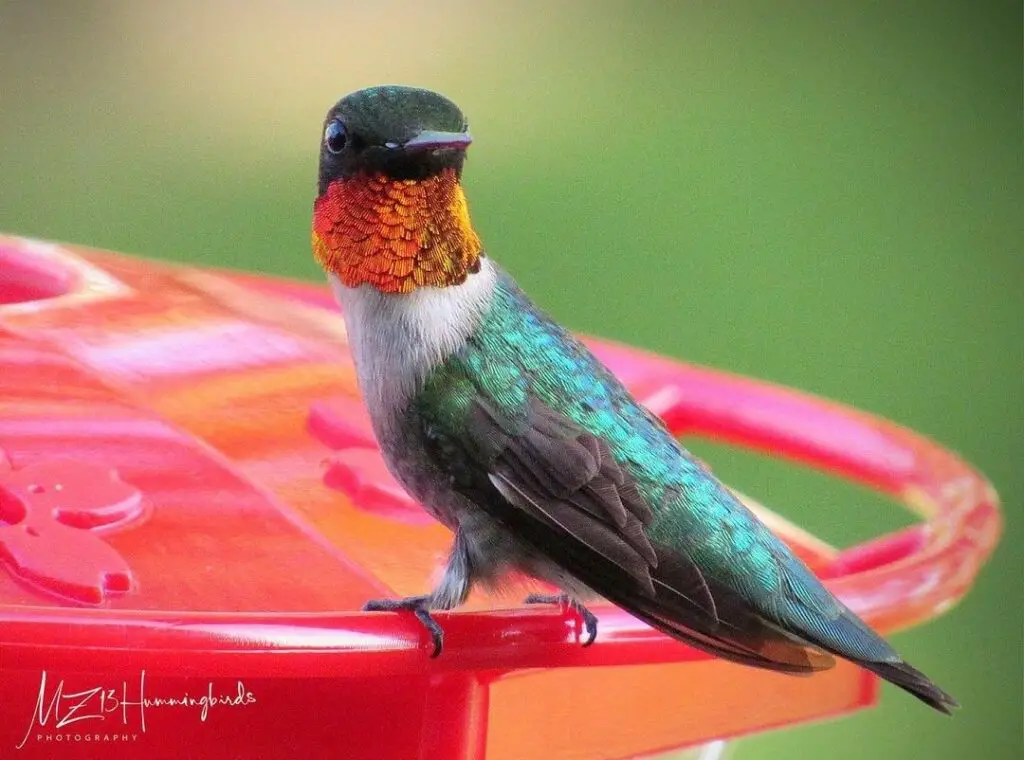
Photo by: mz13hummingbirds
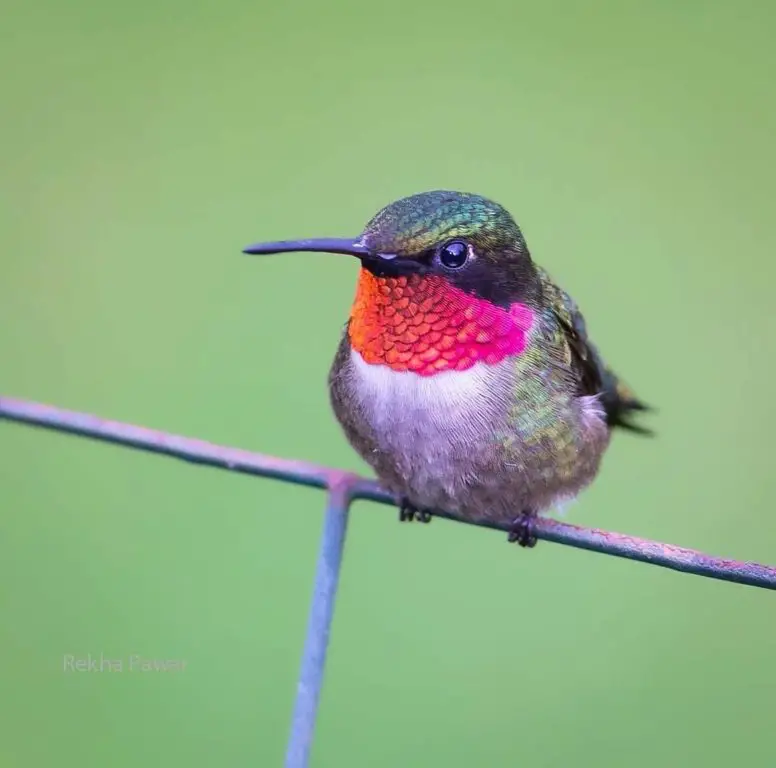
Photo by: Rekha Pawar
Female Ruby-throated hummingbirds:
Ruby-throated hummingbird females are usually larger than males, with a white throat stippled with light spots.
Ruby-throated hummingbird’s life expectancy is roughly three to five years.
The oldest female Ruby-throated hummingbird on record, at nine years old, is nearly twice as old as the male life expectancy.
See my article: Hummingbird Parents: (Mating to Nesting)
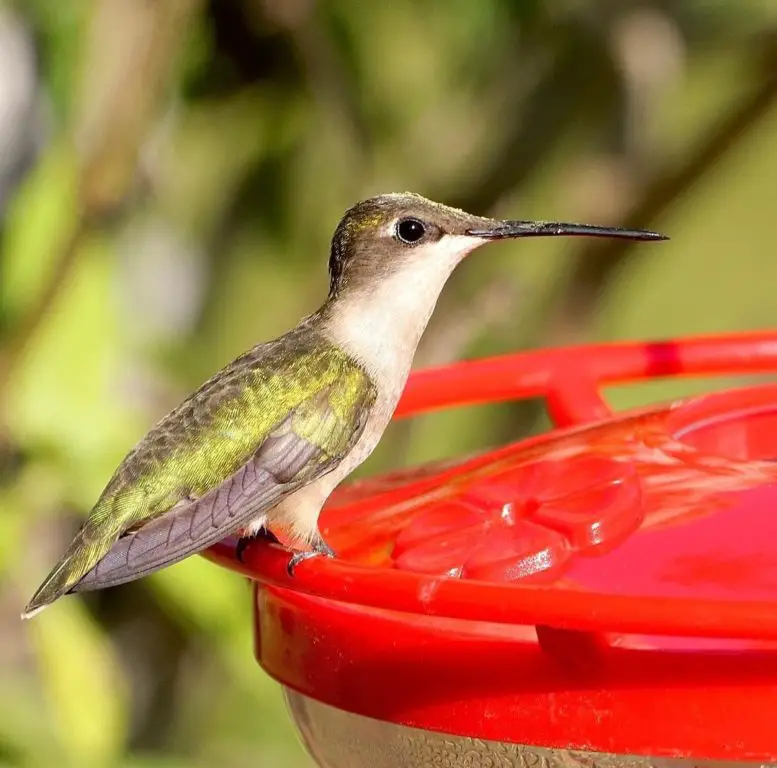
Photo by: Dgen.photos
Note: The pollen on her head and beak. This female Ruby-throated hummingbird has been busy pollinating and drinking nectar from flowers to sustain her high metabolism.
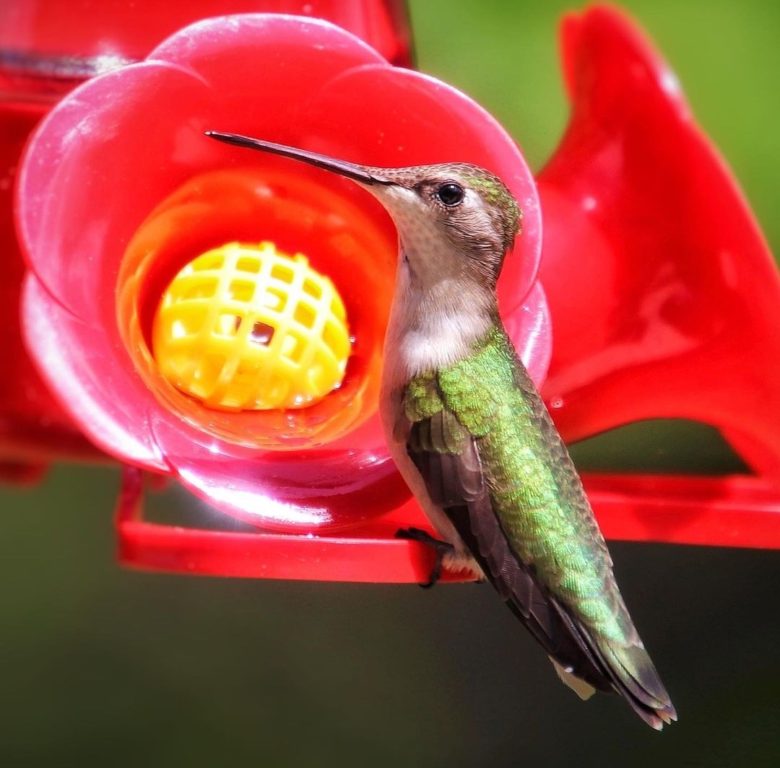
Photo by: Paula Leftwich
Juvenile Ruby-throated hummingbirds:
Ruby-throated hummingbird juveniles, both male and female, have a white throat with faint stippling, just like their mother.
As the males become older, they start to show some color around their necks, and finally their stronger red throat feathers take center stage and proudly show off a vibrant gorget.
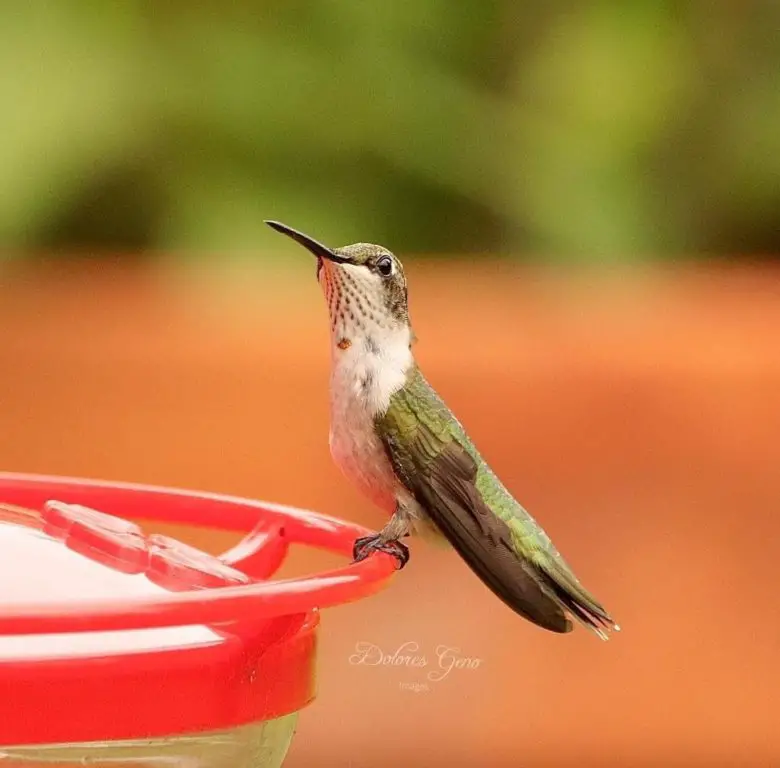
Photo by: Dgen.photos
Note: The throat feathers are slowly coming in, displaying a few dots of color near the neckline and showing the first stages of adolescence.
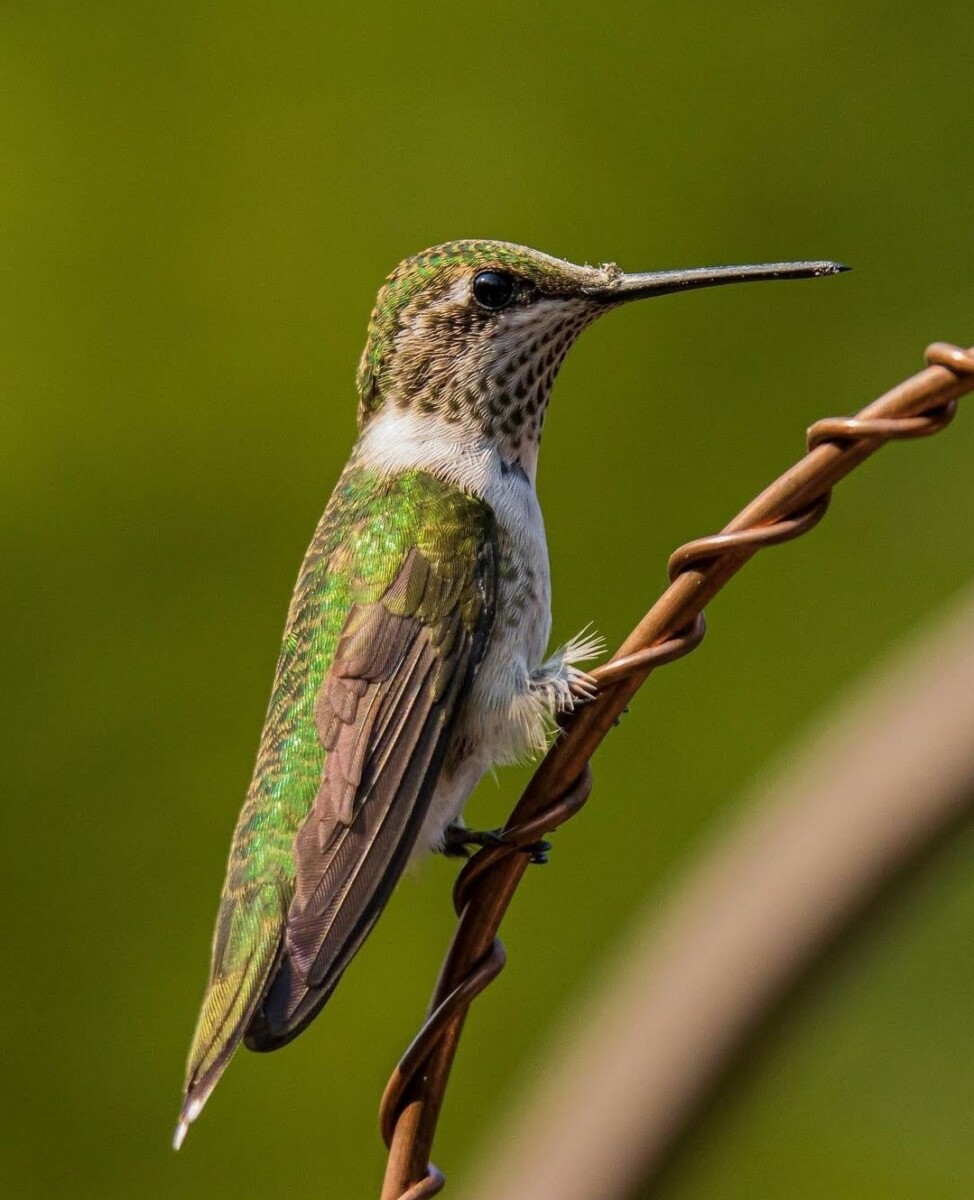
Photo by: MaryLou Ziebarth
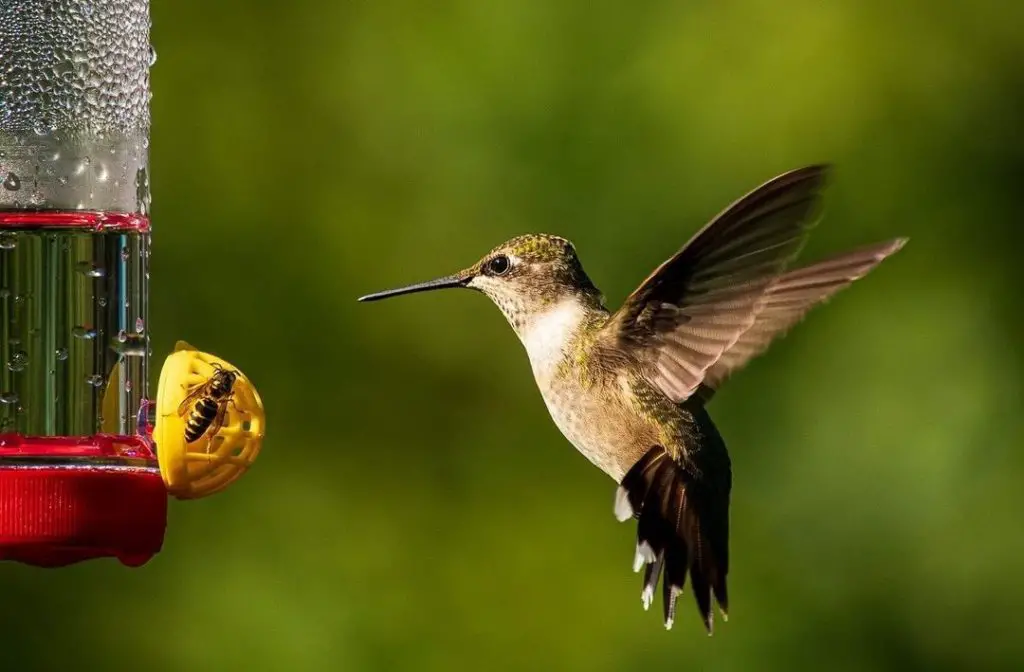
Photo by: MaryLou Ziebarth
Note: This juvenile Ruby-throated hummingbird is struggling with a bee or wasp situation at the feeder.
See my article: Bees On My Hummingbird Feeder: (9 Tips To Get Rid of Them)
Baby Ruby-throated hummingbirds:
Baby Ruby-throated hummingbirds are easily identified by their undertail coverts, which are white fluffy feathers near their bottom that will disappear as they age.
See my article: Baby Hummingbirds: (Egg to Fledgling)
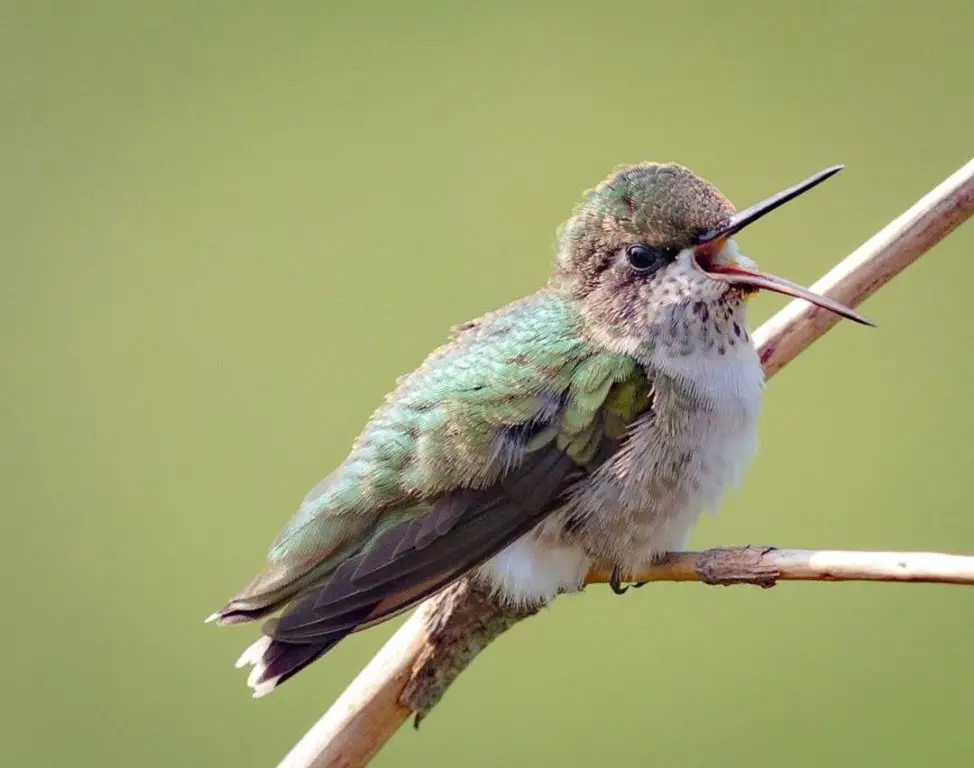
Photo by: Rekha Pawar
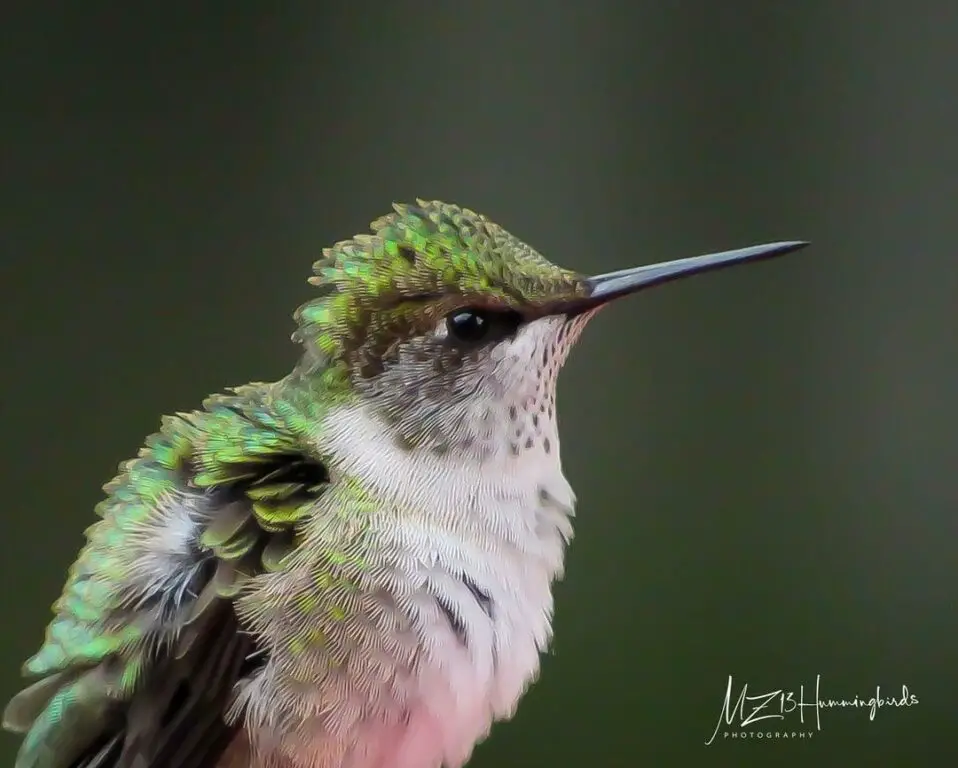
Photo by: Mz13hummingbirds
To see the current sighting map of Rhode Island’s Ruby-throated hummingbirds, click the link.
Hear the sounds of the Ruby-throated hummingbird (Cornell Lab of Ornithology link).
99% of all Rhode Island hummingbird sightings will be Ruby-throated hummingbirds.
On average, out of 10,000 hummingbird sightings in Rhode Island, 9,906 will be Ruby-throated hummingbirds.
The Ruby-throated hummingbird migrates via two different routes in the spring and fall.
The first migration route takes them directly, via the Gulf of Mexico, southwest to Mexico, where they travel nonstop until they reach Central America for the winter.
Over 500 miles is the flight distance over the Gulf of Mexico. Despite being the direct “short” route, these birds must overcome many difficulties.
The total direct flight from Providence, Rhode Island, to Panama City, Panama is 2,375 miles.
Not being able to rest, not having access to food or fuel, and needing to steer clear of the severe tropical Atlantic hurricanes while traveling to their destination are some of the challenges faced when flying over the Gulf of Mexico.
To exacerbate the situation, they migrate during the night or are conducting a “Red-eye flight,” depending on your point of view.
Even though both sexes double their body fat before beginning their arduous transoceanic migratory pattern across the Gulf of Mexico, researchers think that males’ energy consumption is more taxing due to their small stature.
The second land migration path is 4,675 miles long and follows the Gulf of Mexico’s shoreline. Even though there are fewer guarantees of food sources along the way, taking the “long” route gives them the chance to stop and replenish.
Scientists are unclear and continue to investigate why one group of birds would prefer to take one route over the other.
Read my article: Hummingbird Migration in Rhode Island
The majority of people are unaware of how tolerant hummingbirds are of chilly weather.
According to eBird.org, through branding practices in Wisconsin, the Ruby-throated and Rufous hummingbirds have been documented surviving in temperatures of -9F and wind chills of -36F.
Read my article: 3 Reasons Why Hummingbirds Are Banded
To provide the many hummingbirds that spend the winter in Rhode Island access to life-sustaining nectar, several Rhode Island hummingbird enthusiasts keep their hummingbird feeders up all winter long.
This altruistic deed also supplies nectar to other migrating species that are too injured or elderly to travel.
Read my article: 11 DIY Ways to Keep Hummingbird Nectar From Freezing
The Ruby-throated hummingbird is a common sight in parks, gardens, and backyards. It prefers open forests. Except for the breeding season, when they become ferociously territorial and hostile against hummingbirds of other species, they are solitary birds.
Despite their aggressive nature, these hummingbirds are eaten by predators like dragonflies, big crustaceans, praying mantises, and orb-weaver spiders.
Read my article: 10 Common Things That Kill Hummingbirds
Nine years and one month was the oldest known living female Ruby-throated hummingbird, found during a capture and release banding operation in West Virginia.
Read my article: 3 Reasons Why Hummingbirds Are Banded
Rhode Island Hummingbirds That Are Rare/Vagrant
There are five Rhode Island hummingbirds classified as rare or vagrant hummingbirds. They are the Rufous, Calliope, Allen’s, Anna’s and Broad-tailed hummingbirds.
Hummingbirds that live in a group outside of their typical geographic range are classified as belonging to this category.
These hummingbird species not only span a vast range of distinct geographic areas, but they are also known to occasionally interbreed, giving rise to hybrids.
Although they are not in their usual range, reports of seeing these hummingbirds in Rhode Island have been made.
To see a current sighting map of Rhode Island rare/vagrant hummingbirds, click the links below:
RUFOUS HUMMINGBIRD – (Selasphorus rufus)
Conservation Status: Near threatened
Kingdom: Animalia
Phylum: Chordata
Class: Aves
Order: Apodiformes
Family: Trochilidae
Genus: Selasphorus
Species: S. rufous
The Latin word rubrum, which means “red,” is the source of the Rufous hummingbird’s name due to its reddish-brown color.
Male Rufous hummingbirds:
The orange-red gorget of a male rufous hummingbird is iridescent, and their tail and sides have a rusty hue. Their underside is beige to white, and their bill is black.
Along with chocolate brown dorsal feathers, males can also have green plumage with green spots on their rustic-looking backs or on the summit of their heads.
They weigh 3.2 grams and range in length from 2.8 to 3.5 inches.
The metal plate that shields the wearer’s throat during combat to prevent injuries is the inspiration behind the name of the gorget on a male hummingbird.
This name is acceptable and fitting to characterize the physical characteristics of male hummingbirds, since they fight fiercely for their own territory.
Read my article: Hummingbird Gorgets Explained
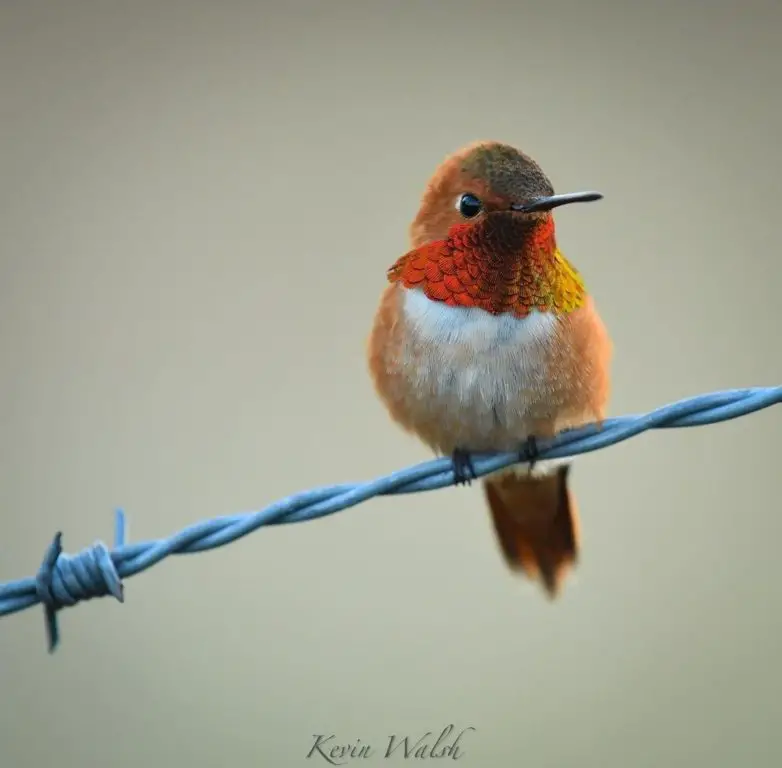
Photo by: Kevin Walsh
Female Rufous hummingbirds:
The female Rufous hummingbird is less colorful than the male because it lacks a gorget and iridescent feathers.
In the wild, confusion may arise, though, because certain females have stippling or color specs along their throat line that resemble juvenile characteristics.
They are slightly larger than the males in anticipation of producing offspring.
See my article: Hummingbird Parents: (Mating to Nesting)
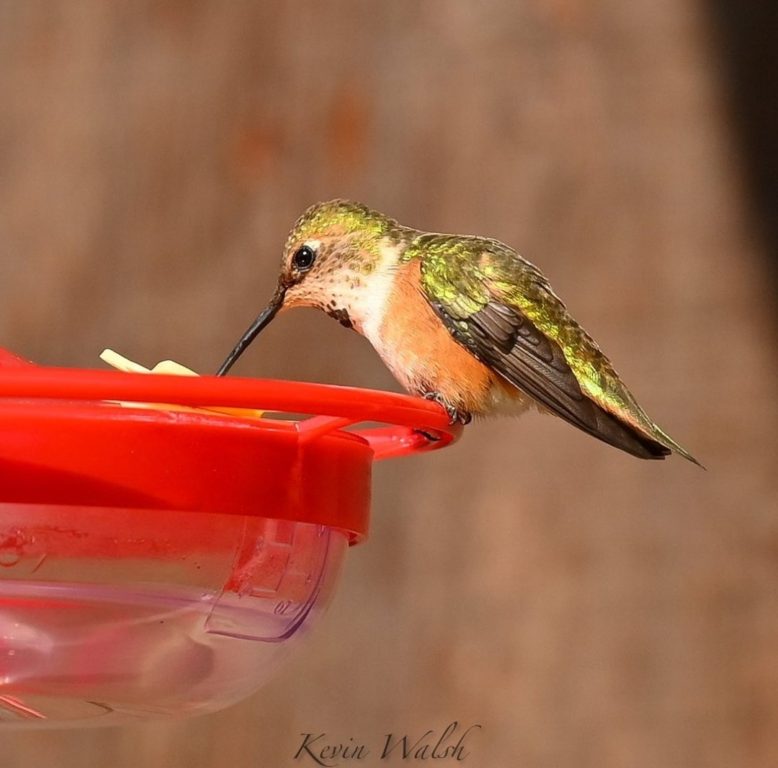
Photo by: Kevin Walsh
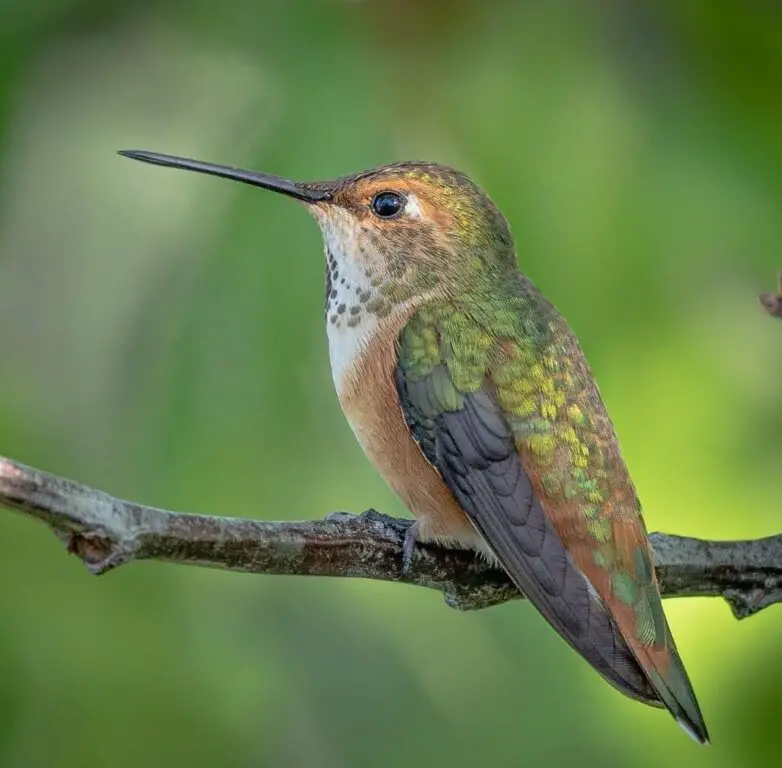
Photo by: Bob Free
They have one of the northernmost breeding ranges of any hummingbird in the world; migrating north from Mexico and nesting as far north as Alaska to breed during the summer months.
They are polygamous and will mate with several partners in a season.
Read my article: Hummingbird Parents: (Mating to Nesting)
Read my article: Baby Hummingbirds: (Egg to Fledgling)
Juvenile Rufous hummingbirds:
In the wild, juvenile Rufous hummingbirds and Allen’s hummingbirds are nearly identical in terms of color and behavior.
Therefore, range rather than appearance is used to establish identity.
The juvenile male Rufous’ rustic appearance is attributed to the iridescent orange dots on their neck.
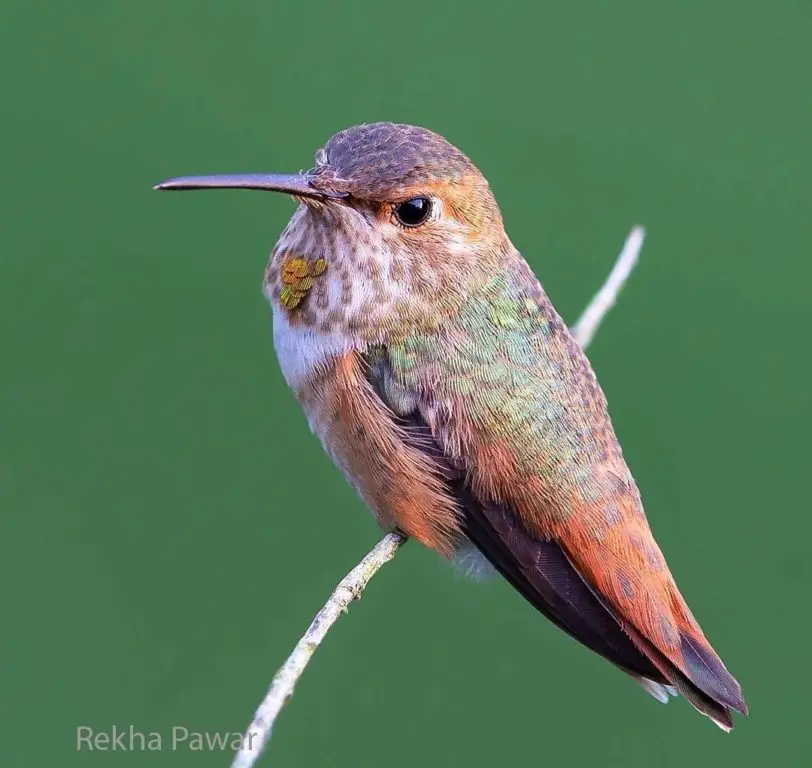
Photo by: Rekha Pawar
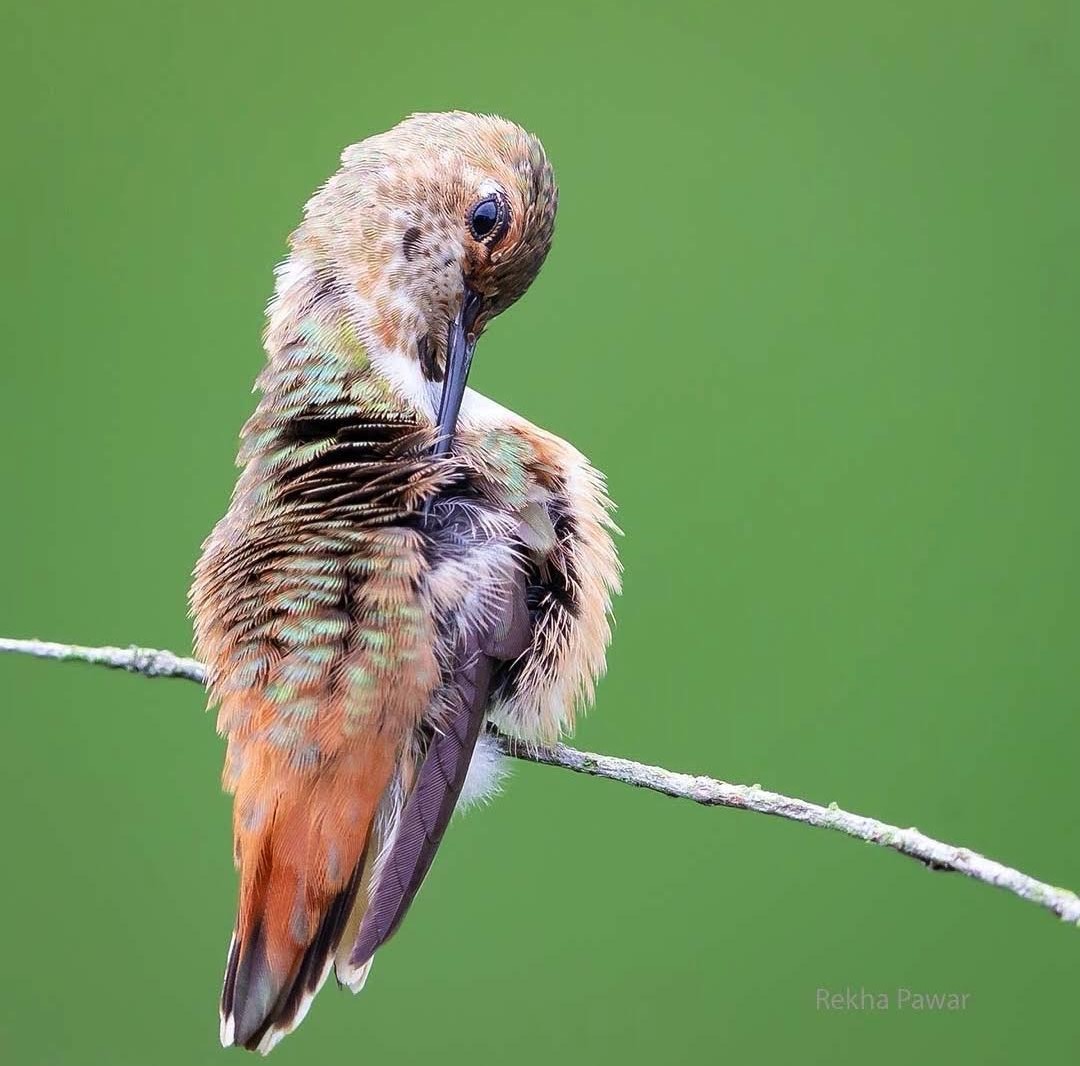
Photo by: Rekha Pawar
Note: Preening flight feathers is an important daily routine to maintain hygiene and to keep the feathers flexible, strong, in alignment, and parasite-free.
Baby Rufous hummingbirds:
Baby Rufous hummingbirds are easily identified by their undertail coverts, which are white fluffy feathers near their bottom that will disappear as they age.
See my article: Baby Hummingbirds: (Egg to Fledgling)
To see the current sighting map of Rufous hummingbirds in Rhode Island, click the link.
Hear the sounds of the Rufous hummingbird (Cornell Lab of Ornithology link).
0.93% of all Rhode Island hummingbird sightings will be Rufous hummingbirds.
On average, out of 10,000 hummingbird sightings in Rhode Island, only 83 will be Rufous hummingbirds.
Of all the birds in the world, Rufous hummingbirds migrate within the United States for the longest period of time. Every year, they traverse 3,900 miles in a clockwise manner around western America.
This migratory pattern during the seasons coordinates their arrival perfectly while catching nectar and blooming flowers throughout the year, fueling their bodies for their long journey.
These friendly environments offer and guarantee safe trips in addition to a dependable haven for relaxation and refueling while on the road.
A large number of Rufous hummingbirds will choose to move south to Mexico rather than stay in Rhode Island for the winter. Hummingbirds, however, can withstand far lower temperatures than most people think.
According to eBird.org, through branding practices in Wisconsin, the Rufous and Ruby-throated hummingbirds are documented to survive in temperatures of -9F and wind chills of -36F.
See my article: 3 Reasons Why Hummingbirds Are Banded
Many Rhode Island hummingbird admirers leave hummingbird feeders up all winter long to provide life-nourishing nectar to the Rufous hummingbird.
This selfless act also provides nectar to other injured or older hummingbirds that are unable to migrate.
See my article: 11 DIY Ways to Keep Hummingbird Nectar From Freezing
When it comes to other hummingbirds and animals, Rufous hummingbirds are fiercely possessive and hostile. They are known for being aggressive and bold, driving large birds and rodents away from their favorite feeders in addition to other hummingbirds.
See my article: Why Hummingbirds Chase Each Other: Is it Friend or Foe?
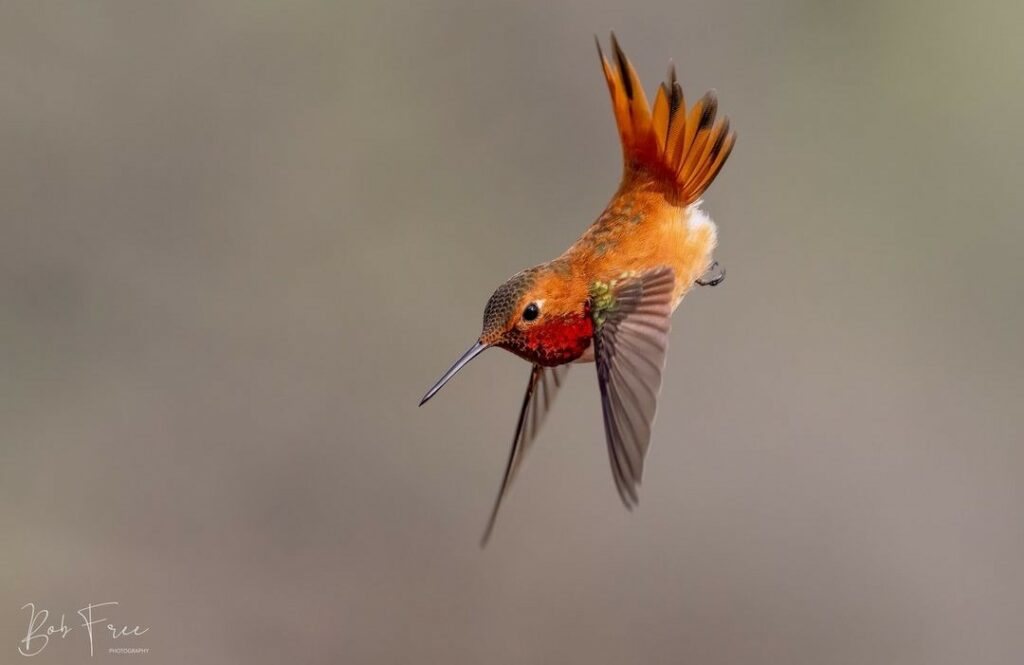
Photo by: Bob Free
It has even been observed that female mothers may attack squirrels and chipmunks that approach their nest too closely.
Due to their remarkable memory, Rufous hummingbirds have been observed to search for an abandoned hummingbird feeder years after it has been taken down.
Read my article: Hummingbird Adaptation and Remarkable Ability to Locate Food
Because of their unparalleled flying acrobatics, Rufous hummingbirds are fierce competitors at feeders, outmaneuvering all other species.
Rufous hummingbirds easily hybridize and cross-breed with other hummingbird species, such as Anna’s hummingbirds.
IUCN Red List classifies the Rufous hummingbird as “near threatened” because of habitat destruction in the Pacific Northwest.
In British Columbia, during a banding operation, the oldest living Rufous hummingbird was documented at 8 years and 10 months old.
Read my article: 3 Reasons Why Hummingbirds Are Banded
CALLIOPE HUMMINGBIRD – (Selasphorus calliope)
Conservation Status: Least concerned
Kingdom: Animalia
Phylum: Chordata
Class: Aves
Order: Apodiformes
Family: Trochilidae
Genus: Selasphorus
Species: S. calliope
Calliope hummingbirds are named after a Greek mythological muse, who represented poetry and eloquence. Calliope means “beautiful voice” in ancient Greek.
Male Calliope hummingbirds:
The long, stunning row of feathers that protrude down the sides of the throat and their iridescent purple cap are characteristics that make male Calliope hummingbirds clearly identifiable.
These hummingbirds, which are 3 inches long and weigh 2-3 grams, have shiny green backs like many others.
The metal plate that shields the wearer’s throat during combat to prevent injuries is the inspiration behind the name of the gorget on a male hummingbird.
This name is acceptable and fitting to characterize the physical characteristics of male hummingbirds since they fight fiercely for their own territory.
Read my article: Hummingbird Gorgets Explained
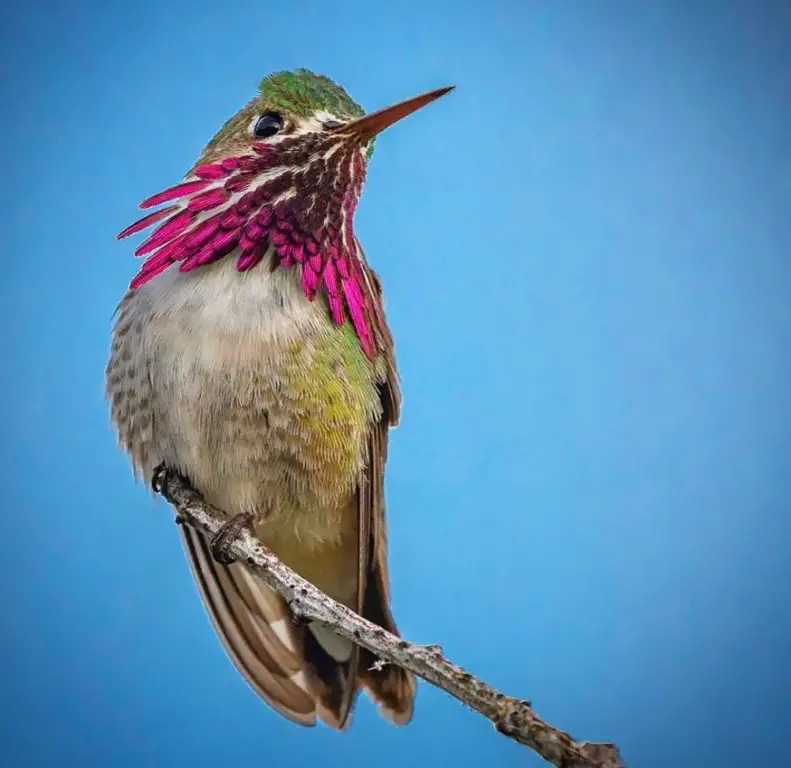
Photo by: sony_alpha_male
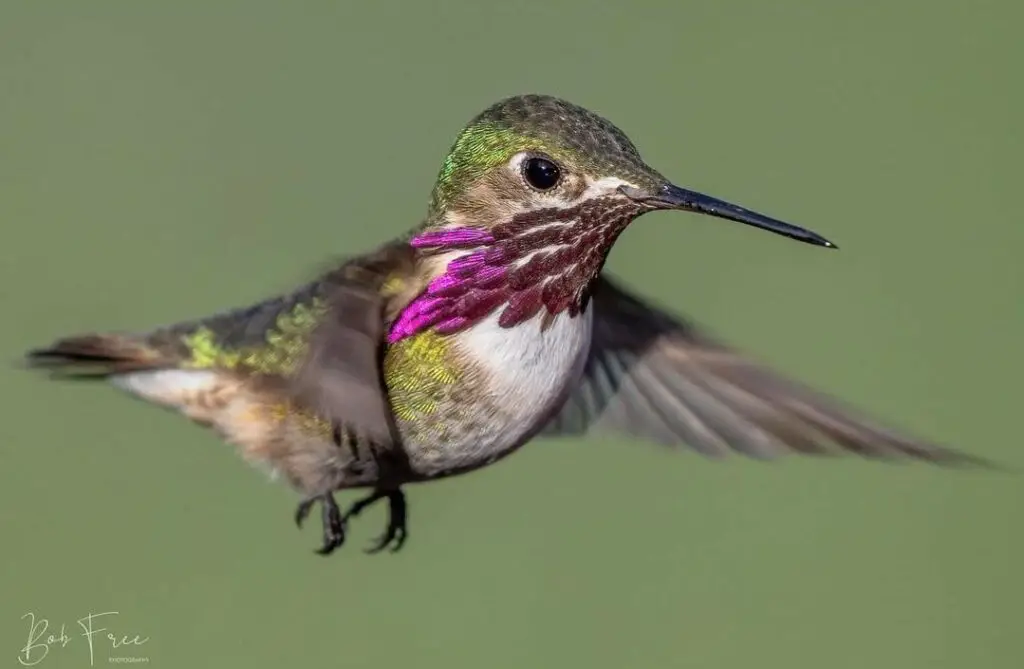
Photo by: Bob Free

Photo by: Bob Free
Female Calliope hummingbirds:
The female Calliope hummingbird is less colorful than the male and lacks a gorget and iridescent feathers. Their head’s crown, or top, has a grayish-green hue.
The buff hue of the flanks refers to the sides, underbelly, and area beneath the wings.
See my article: Hummingbird Parents: (Mating to Nesting)
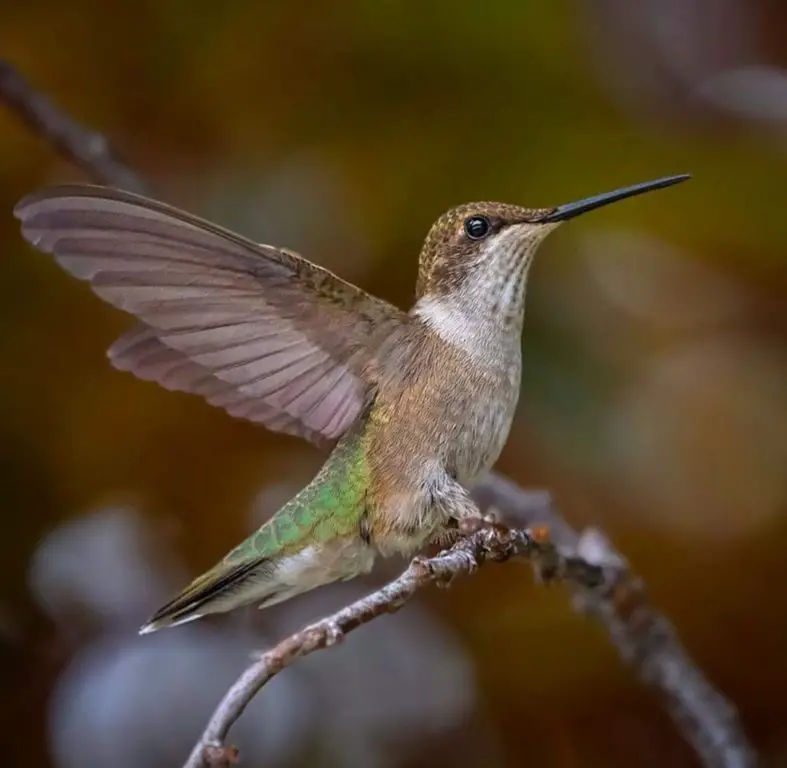
Photo by: sony_alpha_male
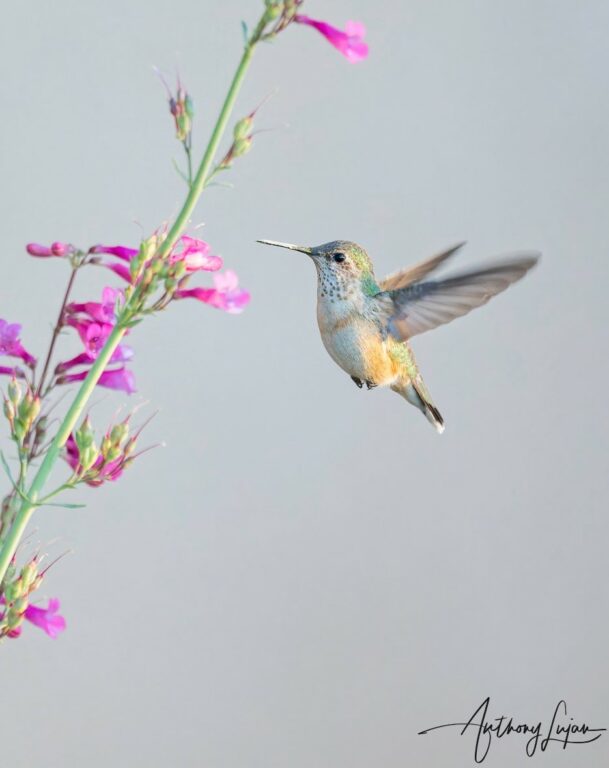
Photo by: Anthony Lujan
Juvenile Calliope hummingbirds:
Male and female juvenile Calliope hummingbirds initially resemble adult females until the male starts to develop the iridescent feathers that are characteristic of this species of hummingbird.
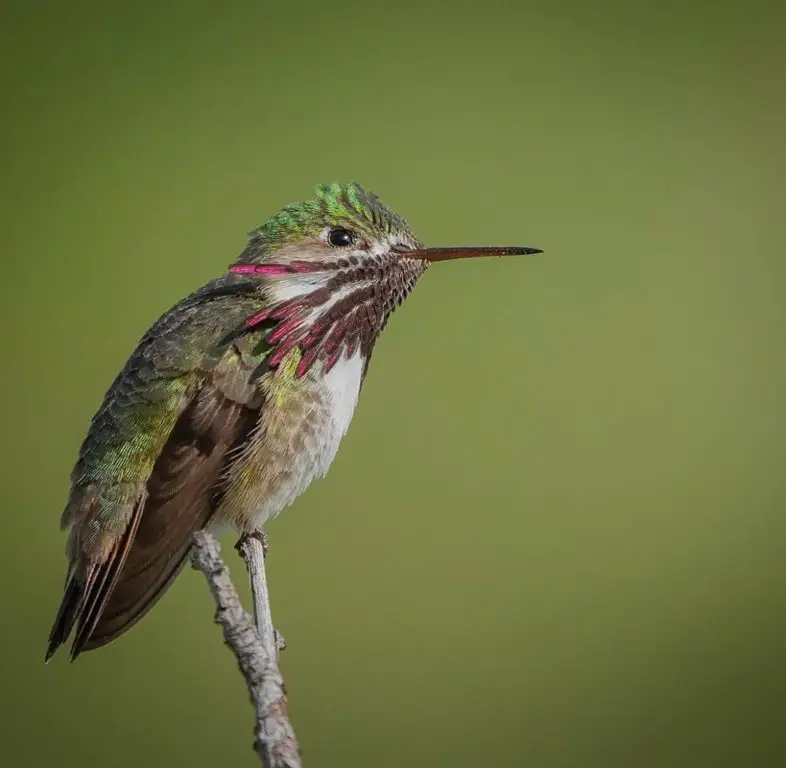
Photo by: sony_alpha_male
Baby Calliope hummingbirds:
Baby Calliope hummingbirds are easily identified by their undertail coverts, which are white fluffy feathers near their bottom that will disappear as they age.
See my article: Baby Hummingbirds: (Egg to Fledgling)
To see the current sighting map of the Calliope hummingbird in Rhode Island, click the link.
Hear the sounds of the Calliope hummingbird (Cornell Lab of Ornithology link).
1% of all Rhode Island hummingbird sightings will be Calliope hummingbirds.
On average, out of 10,000 hummingbird sightings in Rhode Island, only 1 will be a Calliope hummingbird.
Like many other hummingbirds, Calliopes use their feathers to manipulate their flight path in order to produce a variety of buzzing noises that serve as a type of language.
The male will fervently fly back and forth and perform a “U” shaped courtship display to get the attention of the female when she is quietly perched.
He will perform a vocal serenade for the female while swaying his body back and forth in front of her.
See my article: Hummingbird Dance: 5 Interpretive Explanations
A breeding area is established by male Calliope hummingbirds, who mate with any female that accepts their wooing.
In terms of social behavior, Calliope hummingbirds are generally solitary, especially outside of the breeding season. They are territorial, with males often defending prime feeding territories from other hummingbirds.
See my article: Why Hummingbirds Chase Each Other: Is it Friend or Foe?
The world’s smallest long-distance migratory bird is the Calliope hummingbird. Their springtime migration patterns resemble those of Rufous hummingbirds.
Throughout their northward spring migration where they breed, they traverse the Pacific Flyways. On their southbound journey in the fall, they pass through the Pacific and Rocky Mountain Flyways towards their wintering destination in Mexico.
During the breeding season, female Calliope hummingbirds select the tips of pine cones as her building site for her nest. Along with stealing materials from other birds’ nests to build her own, she will also disassemble and recycle previous seasons’ nests.
Therefore, larger and more aggressive hummingbirds, such as Allen’s and Rufous hummingbirds, frequently chase and attack female Calliopes. Compared to other species, the Calliope keeps a low profile in order to evade these attacks.
Calliope hummingbirds hybridize and readily crossbreed with other hummingbird species, such as the Costa’s hummingbird.
Calliope hummingbirds are especially susceptible to habitat loss and natural catastrophes like wildfires and climate change because they have a smaller wintering range than other hummingbird species.
The oldest known female Calliope hummingbird was twice captured during a 2007 and 2014 banding operation in Idaho. She was 8 years and 11 months old at the time of her capture.
See my article: 3 Reasons Why Hummingbirds Are Banded
Top Google-ranked websites recognize the Allen’s hummingbird as a Rhode Island hummingbird, despite the fact that Allen’s are not one of the three species recorded as being seen in Rhode Island on a national hummingbird sighting map.
ALLEN’S HUMMINGBIRD – (Selasphorus sasin)
Conservation Status: Least concerned
Kingdom: Animalia
Phylum: Chordata
Class: Aves
Order: Apodiformes
Family: Trochilidae
Genus: Selasphorus
Species: S. sasin
The scientific name of the Allen’s hummingbird is Selasphorus sasin.
The common name of the Allen’s hummingbird is in commemoration of Charles Andrew Allen (1841-1930), an American collector and taxidermist.
Male Allen’s hummingbirds:
Male Allen’s hummingbirds are green-backed with a green forehead and rust-colored flanks, rump, and tail. When their tail feathers are fanned out you can see their chocolate-colored tips.
The gorget of the male Allen’s hummingbird is an iridescent orange-red, however, in darker lighting, it can appear chocolate brown.
Allen’s hummingbirds are 3.3 inches to 3.5 inches in length and weigh 2-4 grams.The metal plate that shields the wearer’s throat during combat to prevent injuries is the inspiration behind the name of the gorget on a male hummingbird.
This name is acceptable and fitting to characterize the physical characteristics of male hummingbirds, since they fight fiercely for their own territory.
Read my article: Hummingbird Gorgets Explained
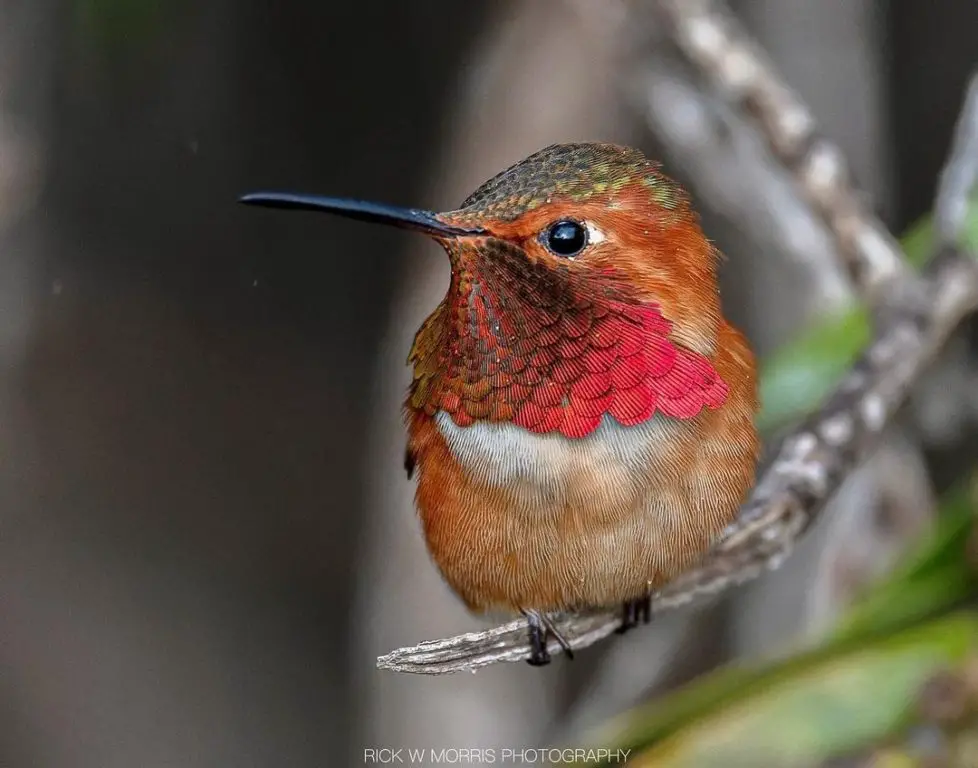
Photo by: IntheWildwithRick
Female Allen’s hummingbirds:
The female Allen’s hummingbird is less colorful than the male because it lacks the iridescent gorget.
In the wild, confusion may arise because certain females have stippling or color specs along their throat lines that resemble juvenile characteristics.
See my article: Hummingbird Parents: (Mating to Nesting)
See my article: Baby Hummingbirds: (Egg to Fledgling)
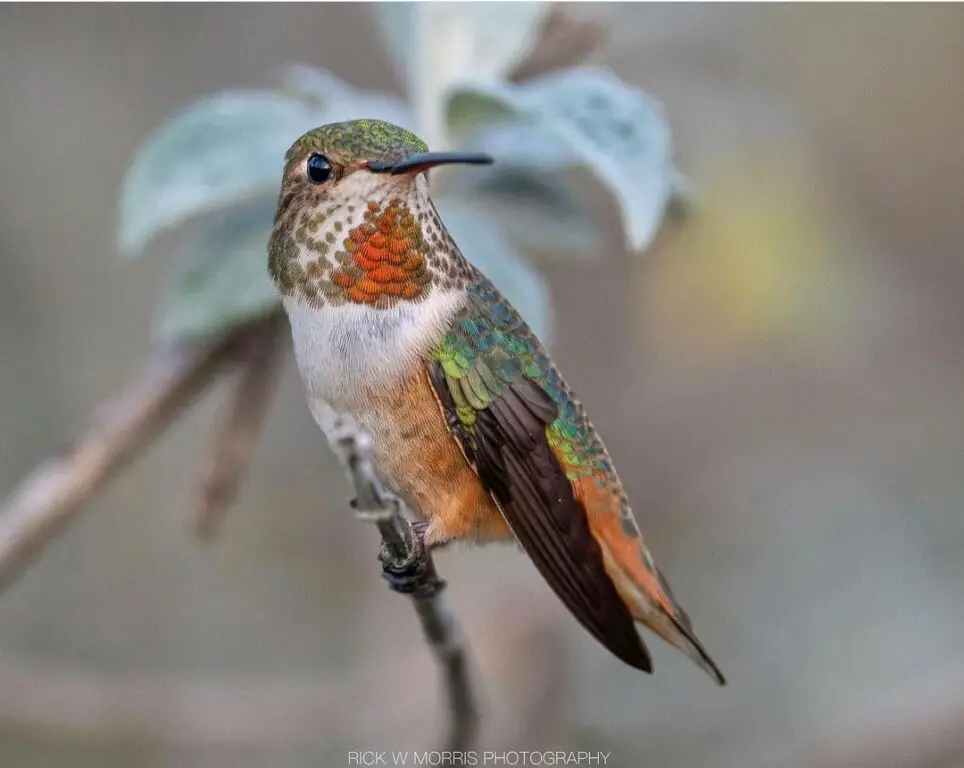
Photo by: IntheWildwithRick
Juvenile Allen’s hummingbirds:
Both male and female juvenile Allen’s hummingbirds first resemble adult females until the male starts to develop the characteristic iridescent feathers of this species of hummingbird.
In the field, they are nearly identical to Rufous hummingbirds due to their striking similarity in colors and disposition.
Therefore, range rather than appearance is used to establish identity.
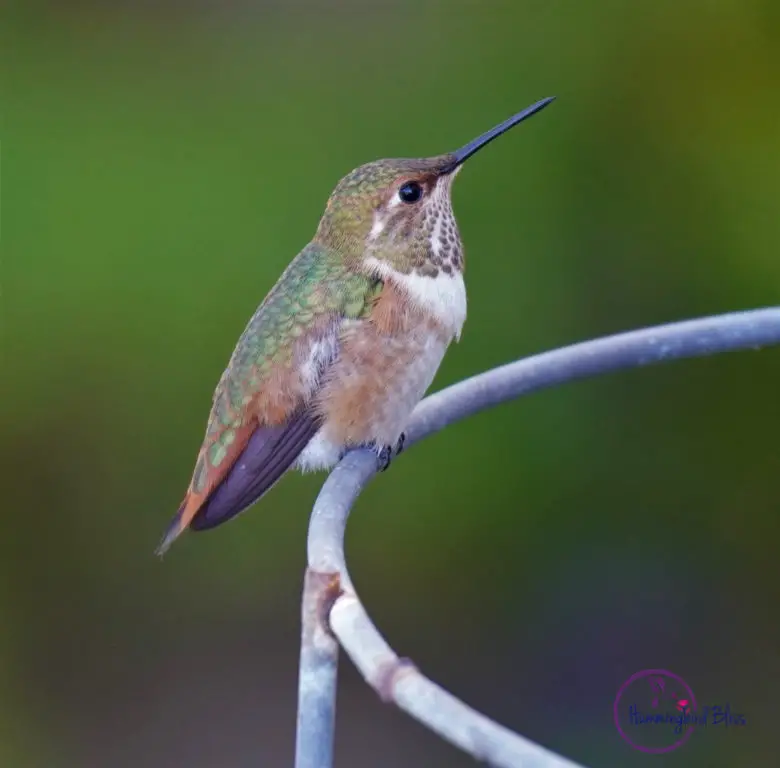
Baby Allen’s hummingbirds:
Baby Allen’s hummingbirds are easily identified by their undertail coverts, which are white fluffy feathers near their bottom that will disappear as they age.
See my article: Baby Hummingbirds: (Egg to Fledgling)
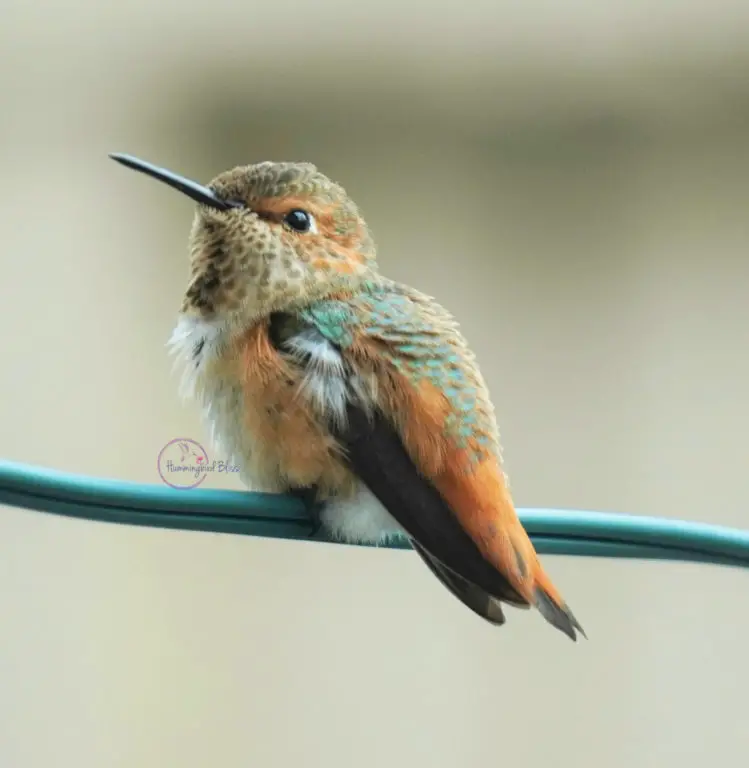
To see the current sighting map of Rhode Island’s Allen’s hummingbirds, click the link.
Hear the sounds of the Allen’s hummingbird (Cornell Lab of Ornithology link).
Male Allen’s hummingbirds engage in a dramatic, fast-paced courtship dance that mimics a pendulum’s swing. Of all the hummingbirds in North America, their territorial dive displays are among the most intricate.
See my article: Hummingbird Dance: 5 Interpretive Explanations
Allen’s hummingbirds, both male and female, are gregarious birds. Other than mating, they do not interact with each other.
They are fiercely territorial and hostile toward other hummingbirds as well as larger predatory birds like hawks, much like Rufous hummingbirds.
Allen’s hummingbirds are primarily found in coastal parts of California and Oregon, USA. They prefer habitats like gardens, forested or shrubby areas, and coastal chaparral.
They migrate to southern Mexico in the winter, covering quite long distances for such small birds.
Allen’s hummingbirds are highly territorial, especially the males during the breeding season. They engage in aggressive aerial displays to defend their feeding territories from intruders. These displays include high-speed chases and intricate flight patterns.
See my article: Why Hummingbirds Chase Each Other: Is it Friend or Foe?
Allen’s hummingbirds commonly reside and nest along the west coast and winter in Mexico. Their nesting season is perfectly timed with when the regions have the most rainfall which helps provide prolific nectar producing flowers for their offspring.
Usually found in trees or shrubs, females use plant materials and spider webs to construct tiny, cup-shaped nests. Each time they attempt to reproduce, they lay one to two eggs, which they then incubate for two to three weeks.
For several weeks after hatching, the young remain totally reliant on their mother for nourishment and protection until they are able to fly.
In their natural range, Allen’s hummingbirds often visit gardens and areas with bird feeders. They are a favorite among bird watchers and nature enthusiasts for their colorful appearance and lively behavior.
The future of Allen’s hummingbirds, like many species, is closely tied to environmental factors and human influence on their habitats. Habitat loss and the use of pesticides are among the challenges they face. Efforts to preserve natural habitats, along with responsible gardening and the maintenance of bird feeders, aids in their conservation.
Understanding and protecting Allen’s hummingbirds is crucial for maintaining the ecological balance and for the continued enjoyment of future generations who will marvel at this vibrant and lively bird.
In 2004, and again in 2009, the oldest known living Allen’s hummingbird was taken during a California banding program that involved catch and release. She was 5 years and 11 months old at the time.
See my article: 3 Reasons Why Hummingbirds Are Banded
Top Google-ranked websites recognize the Anna’s hummingbird as a Rhode Island hummingbird, despite the fact that Anna’s are not one of the three species recorded as being seen in Rhode Island on a national hummingbird sighting map.
ANNA’S HUMMINGBIRD – (Calypte anna)
Conservation Status: Least concerned
Kingdom: Animalia
Phylum: Chordata
Class: Aves
Order: Apodiformes
Family: Trochilidae
Genus: Calypte
Species: C. anna
The Anna’s hummingbird, scientifically known as Calypte anna, gets its common name from Anna Masséna, the Duchess of Rivoli.
Male Anna’s hummingbirds:
In North America, male Anna’s hummingbirds are the only species of hummingbirds with a red crown. Their predominant colors are magenta, gray, and green.
The male gorget and crown are iridescent magenta, and they are very vivid and showy.
They weigh between 2.4 and 4.5 grams and have lengths ranging from 3.5 to 4.3 inches.
The metal plate that shields the wearer’s throat during combat to prevent injuries is the inspiration behind the name of the gorget on a male hummingbird.
This name is acceptable and fitting to characterize the physical characteristics of male hummingbirds, since they fight fiercely for their own territory.
Read my article: Hummingbird Gorgets Explained
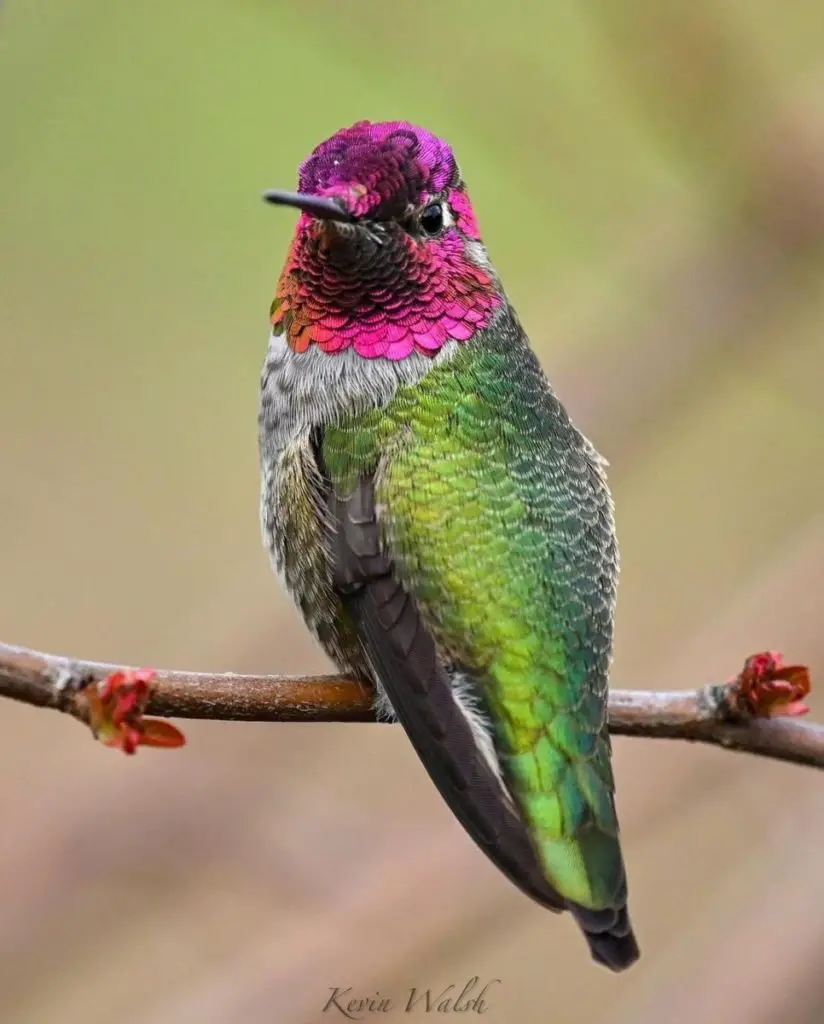
Photo by: Kevin Walsh
Female Anna’s hummingbirds:
Female Anna’s hummingbirds are pale green in hue, not as brilliant as the males.
Although a showy gorget is more prevalent on the males, females can also have them, showing a tiny area of magenta.
Females are identified by the faint white line that usually covers each eye.
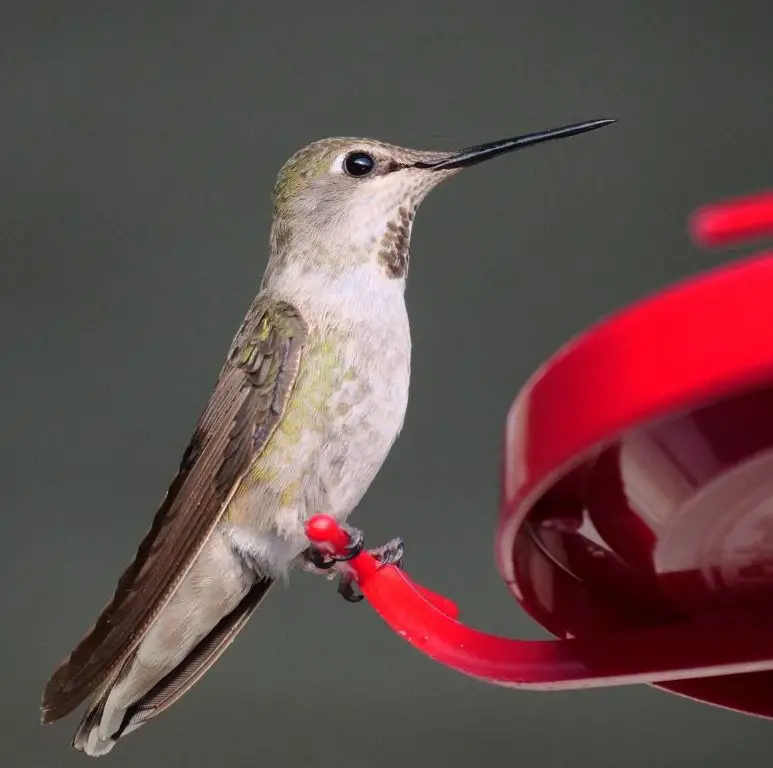
Photo by: Kevin Walsh
Female Anna’s hummingbirds raise their young with no help from the males.
See my article: Hummingbird Parents: (Mating to Nesting)
Juvenile Anna’s hummingbirds:
Juvenile Anna’s hummingbirds, both male and female, look more like adult females until they are differentiated as the male begins to acquire the bright red/magenta gorget.
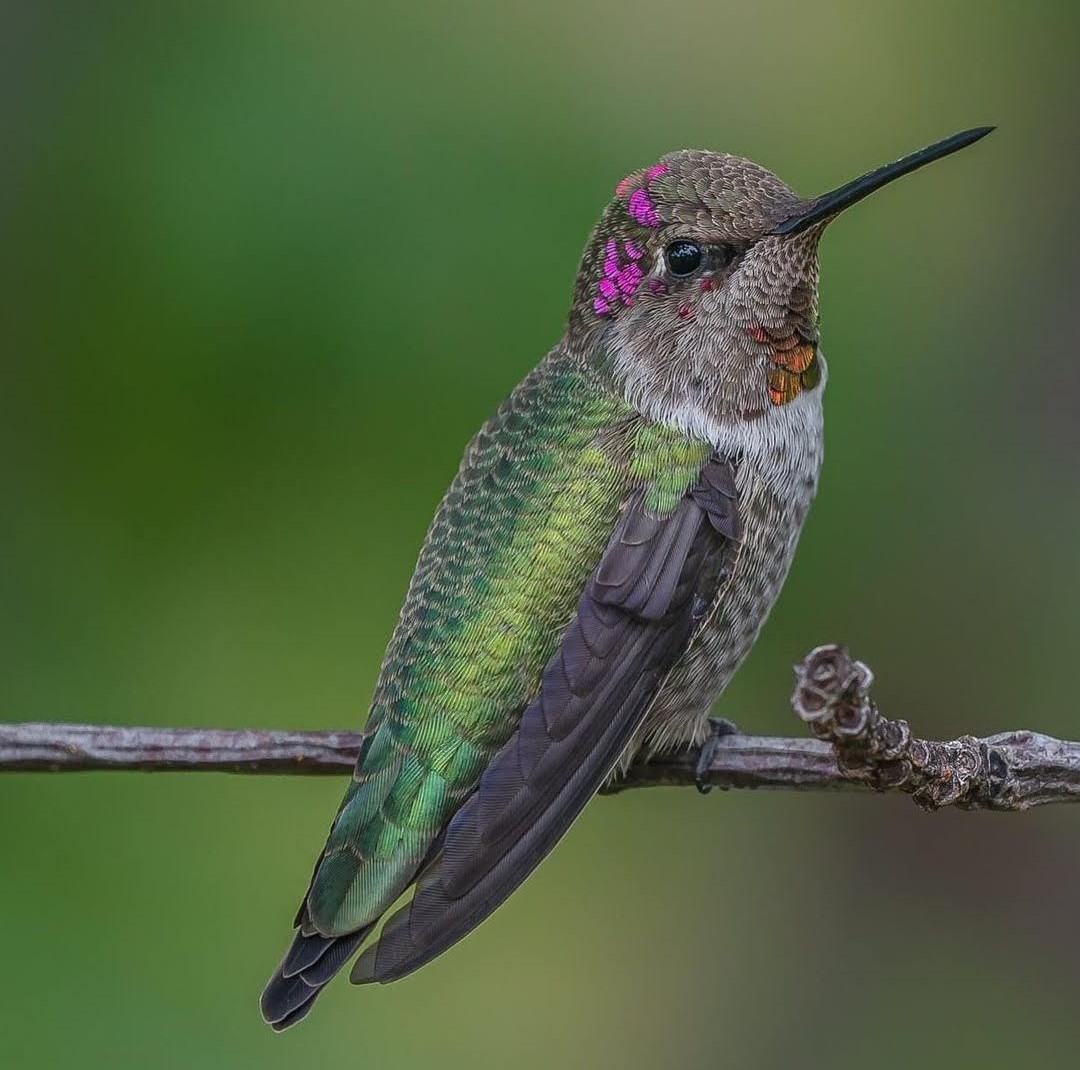
Photo by: Bob Free
Baby Anna’s hummingbirds:
Baby Anna’s hummingbirds are easily identified by their undertail coverts, which are white fluffy feathers near their bottom that will disappear as they age.
See my article: Baby Hummingbirds: (Egg to Fledgling)
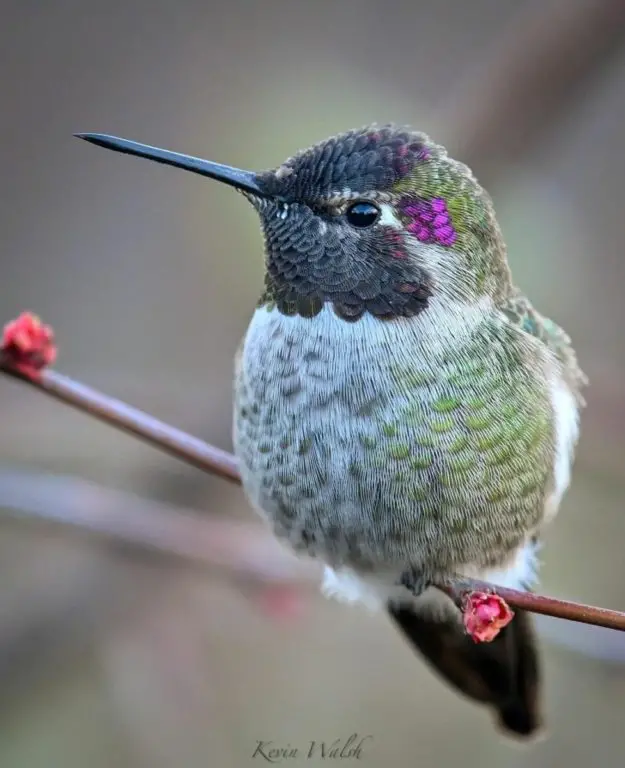
Photo by: Kevin Walsh
To see the current sighting map of Rhode Island’s Anna’s hummingbirds, click the link.
Hear the sounds of the Anna’s hummingbird (Cornell Lab of Ornithology link).
The only hummingbird to reside year-round on the Pacific Coast, the Anna’s hummingbird is a native of the west coast of North America.
Anna’s hummingbirds enjoy a Mediterranean climate with hot, dry summers and fairly wet winters.
This species is a year-round resident in much of its range, unlike many other hummingbirds that migrate.
Male Anna’s are notable for their remarkable diving displays during mating season and their ability to thrive in urbanized areas.
The male Anna’s hummingbird executes dramatic and captivating displays during courtship and diving. The entire dive display lasts 12 seconds from start to finish.
See my article: Hummingbird Dance: 5 Interpretive Explanations
Unlike many northern temperate hummingbirds, male Anna’s hummingbirds sing during courtship along with making vibrations with their tail feathers to attract a female.
Anna’s hummingbirds protect their territory with elaborate dives targeted towards predatory birds and even towards people they perceive to be threatening.
See my article: Why Hummingbirds Chase Each Other: Is it Friend or Foe?
Anna’s hummingbirds hybridize and readily crossbreed with other hummingbird species, such as the Black-chinned, Costa’s, and Rufous hummingbirds.
The oldest male Anna’s hummingbird known to exist was 8 years and 2 months old when he was captured and released during a banding expedition in Arizona.
See my article: 3 Reasons Why Hummingbirds Are Banded
Top Google-ranked websites recognize the Broad-tailed hummingbird as a Rhode Island hummingbird, despite the fact that Broad-tailed hummingbirds are not one of the three species recorded as being seen in Rhode Island on a national hummingbird sighting map.
BROAD-TAILED HUMMINGBIRD – (Selsaphoris platycercus)
Conservation Status: Least concerned
Kingdom: Animalia
Phylum: Chordata
Class: Aves
Order: Apodiformes
Family: Trochilidae
Genus: Selsaphoris
Species: S. platycercus
The scientific name of the Broad-tailed hummingbird is Selasphorus platycercus. This species got its common name from the notably broad tail of the males, which is a distinguishing feature among hummingbirds.
This broad tail, when combined with the hummingbird’s flight patterns, creates a distinctive trilling sound that is also a characteristic of the species. The combination of visual and auditory traits played a significant role in the naming of this bird.
Male Broad-tailed hummingbirds:
An iridescent ruby-red gorget is seen on male Broad-tailed hummingbirds.
Males and females alike, the Broad-tailed hummingbird is characterized by its green upperparts, light underbelly, vivid white eye rings, and widely rounded tails.
They have a medium build, measure from 3.3 and 3.8 inches in length, and weigh 3.6 grams.
The metal plate that shields the wearer’s throat during combat to prevent injuries is the inspiration behind the name of the gorget on a male hummingbird.
This name is acceptable and fitting to characterize the physical characteristics of male hummingbirds, since they fight fiercely for their own territory.
Read my article: Hummingbird Gorgets Explained
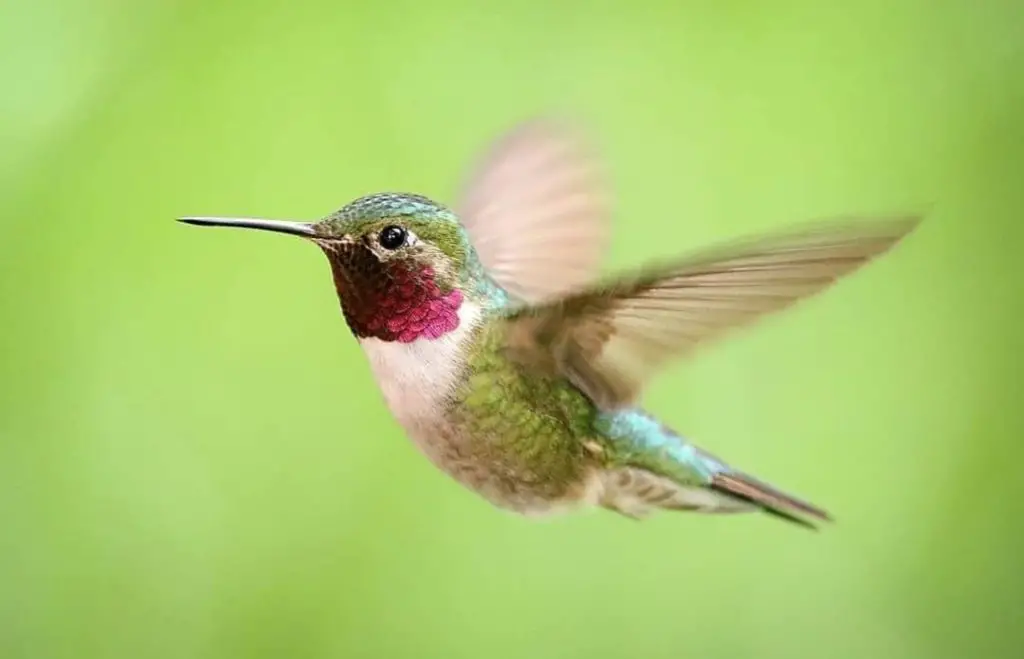
Photo by: bird.whisperer
Female Broad-tailed hummingbirds:
The female Broad-tailed hummingbird is less colorful than the male and lacks a gorget and iridescent feathers.
Their underbellies are pale to beige, with vivid white eye rings and broadly rounded tails.
Their topsides are green, extending from the head to the tail.
See my article: Hummingbird Parents: (Mating to Nesting)
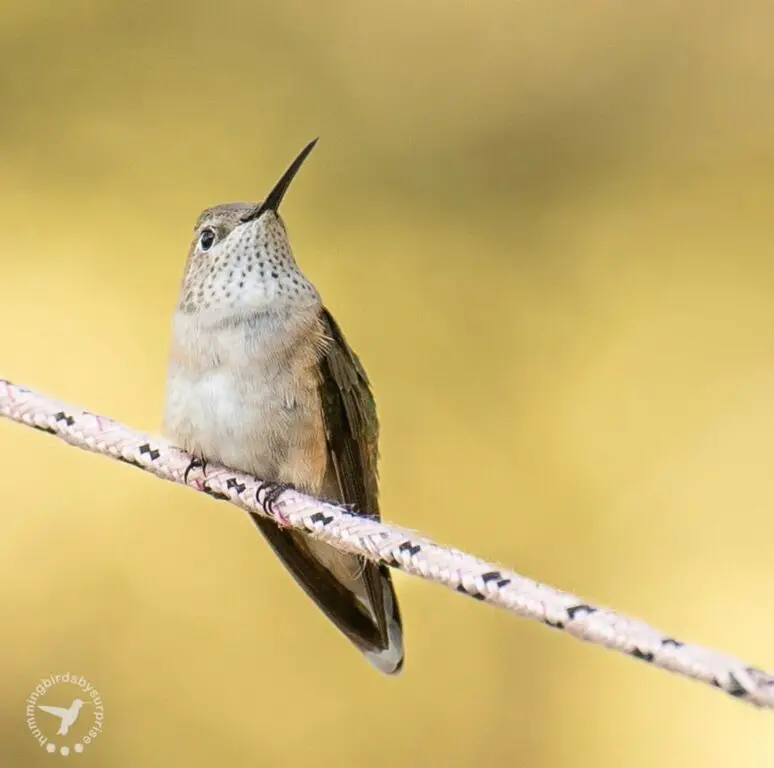
Photo by: hummingbirdsbysuprise
Juvenile Broad-tailed hummingbirds:
Male and female juvenile Broad-tailed hummingbirds initially resemble adult females until the male starts to develop the iridescent feathers that are characteristic of this species of hummingbird.
Baby Broad-tailed hummingbirds:
Baby Broad-tailed hummingbirds are easily identified by their undertail coverts, which are white fluffy feathers near their bottom that will disappear as they age.
See my article: Baby Hummingbirds: (Egg to Fledgling)
To see the current sighting map of Rhode Island’s Broad-tailed hummingbirds, click the link.
Hear the sounds of the Broad-tailed hummingbird (Cornell Lab of Ornithology link).
The Broad-tailed hummingbird travels frequently to the United States near the southern Mexican border.
They have a migrant and non-migrant population that begins in the south of Mexico. The ones that migrate north to breed will do so during spring migration and will pass through Arizona, Colorado, Wyoming, Idaho and reach as far north as Montana.
Once the breeding season is complete, Broad-tailed hummingbirds will depart and begin their southbound fall migration to winter in Mexico and meet up with their non-migrant population.
The Broad-tailed hummingbird favors habitats in the understory of mature forest woodlands such as pine and oak groves. They chose to nest on the branches of trees and have been known to return to the same nesting ground each year, roughly 70% of the time.
Their breeding time coincides with the peak time of flowering native plants for maximum food resource availability. Their favorite nectar-producing flower plants include Red Columbine, Indian Paintbrush, Sage varieties, Currants, and Scarlet Mint.
Broad-tailed hummingbirds hybridize and readily crossbreed with other hummingbird species, such as the Costa’s hummingbird.
In terms of social behavior, Broad-tailed hummingbirds are generally solitary, especially outside of the breeding season. They can be territorial, with males often defending prime feeding territories from other hummingbirds.
See my article: Why Hummingbirds Chase Each Other: Is it Friend or Foe?
The Broad-tailed hummingbird has suffered a decline in population since the 1990s, but presently, its population is stable, and it has been shown to have adapted to human habitat encroachment.
The oldest living Broad-tailed hummingbird, a female, was 12 years and 2 months, recorded during a capture and release banding operation in Colorado.
See my article: 3 Reasons Why Hummingbirds Are Banded
Which Rhode Island Hummingbirds Are Most Frequently Seen In The State?
The most frequently seen Rhode Island hummingbirds are Ruby-throated hummingbirds.
Ruby-throated hummingbirds are 99% of all hummingbirds seen in Rhode Island.
Rhode Island hummingbirds listed in order of frequency seen:
Ruby-throated Hummingbird: 99% of all hummingbirds seen in Rhode Island are Ruby-throated hummingbirds.
Out of 10,000 Rhode Island hummingbirds seen, 9,900 will be a Ruby-throated hummingbird.
Rufous Hummingbird: 0.93% of all hummingbirds seen in Rhode Island are Rufous hummingbirds.
Out of 10,000 Rhode Island hummingbirds seen, only 93 will be Rufous hummingbirds.
Calliope Hummingbird: 0.01% of all hummingbirds seen in Rhode Island are Calliope hummingbirds.
Out of 10,000 Rhode Island hummingbirds seen, only 1 will be a Calliope hummingbird.
Allen’s Hummingbird: There are no sightings of Allen’s hummingbirds on the eBird.org sighting map; however, a top-ranked Google site lists Allen’s hummingbird as a Rhode Island hummingbird.
Anna’s Hummingbird: There are no sightings of Anna’s hummingbirds on the eBird.org sighting map, however, a top-ranked Google site lists Anna’s hummingbird as a Rhode Island hummingbird.
Broad-tailed Hummingbird: There are no sightings of Broad-tailed hummingbirds on the eBird.org sighting map, however, a top-ranked Google site lists the Broad-tailed hummingbird as a Rhode Island hummingbird.
Where In The State Are Rhode Island Hummingbirds Seen?
Hummingbirds are seen in Rhode Island throughout the state.
Ruby-throated hummingbirds are seen throughout the entirety of Rhode Island, while others are only seen in specific, limited areas of the state.
Click the link below to see the current sighting map of where
Rhode Island hummingbirds are being seen (eBird.org links)
- Ruby-throated Hummingbird: This is where, in Rhode Island, current sightings of this hummingbird are being reported.
- Rufous Hummingbird: This is where, in Rhode Island, current sightings of this hummingbird are being reported.
- Calliope Hummingbird: This is where, in Rhode Island, current sightings of this hummingbird are being reported.
- Allen’s Hummingbird: This is where, in Rhode Island, current sightings of this hummingbird are being reported.
- Anna’s Hummingbird: This is where, in Rhode Island, current sightings of this hummingbird are being reported.
- Broad-tailed Hummingbird: This is where, in Rhode Island, current sightings of this hummingbird are being reported.
Read my article: Rhode Island Hummingbird Migration
For more information about hummingbirds, read my other hummingbird articles.
Happy Hummingbird Watching!
Backyard Visitors participates in affiliate programs which compensate us for referring traffic.
